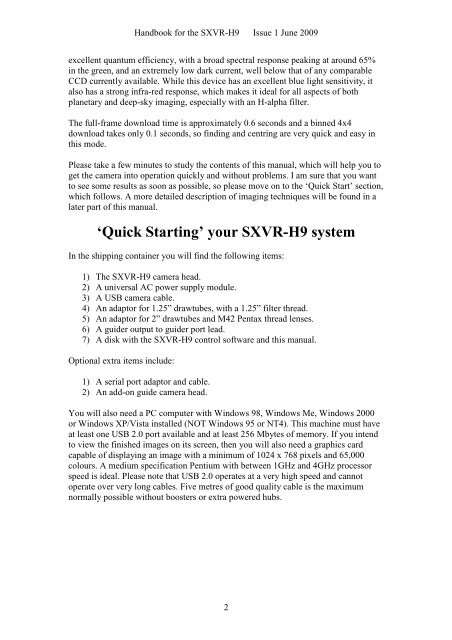SXVR-H9 handbook.pdf - Starlight Xpress
SXVR-H9 handbook.pdf - Starlight Xpress
SXVR-H9 handbook.pdf - Starlight Xpress
You also want an ePaper? Increase the reach of your titles
YUMPU automatically turns print PDFs into web optimized ePapers that Google loves.
Handbook for the <strong>SXVR</strong>-<strong>H9</strong> Issue 1 June 2009<br />
excellent quantum efficiency, with a broad spectral response peaking at around 65%<br />
in the green, and an extremely low dark current, well below that of any comparable<br />
CCD currently available. While this device has an excellent blue light sensitivity, it<br />
also has a strong infra-red response, which makes it ideal for all aspects of both<br />
planetary and deep-sky imaging, especially with an H-alpha filter.<br />
The full-frame download time is approximately 0.6 seconds and a binned 4x4<br />
download takes only 0.1 seconds, so finding and centring are very quick and easy in<br />
this mode.<br />
Please take a few minutes to study the contents of this manual, which will help you to<br />
get the camera into operation quickly and without problems. I am sure that you want<br />
to see some results as soon as possible, so please move on to the ‘Quick Start’ section,<br />
which follows. A more detailed description of imaging techniques will be found in a<br />
later part of this manual.<br />
‘Quick Starting’ your <strong>SXVR</strong>-<strong>H9</strong> system<br />
In the shipping container you will find the following items:<br />
1) The <strong>SXVR</strong>-<strong>H9</strong> camera head.<br />
2) A universal AC power supply module.<br />
3) A USB camera cable.<br />
4) An adaptor for 1.25” drawtubes, with a 1.25” filter thread.<br />
5) An adaptor for 2” drawtubes and M42 Pentax thread lenses.<br />
6) A guider output to guider port lead.<br />
7) A disk with the <strong>SXVR</strong>-<strong>H9</strong> control software and this manual.<br />
Optional extra items include:<br />
1) A serial port adaptor and cable.<br />
2) An add-on guide camera head.<br />
You will also need a PC computer with Windows 98, Windows Me, Windows 2000<br />
or Windows XP/Vista installed (NOT Windows 95 or NT4). This machine must have<br />
at least one USB 2.0 port available and at least 256 Mbytes of memory. If you intend<br />
to view the finished images on its screen, then you will also need a graphics card<br />
capable of displaying an image with a minimum of 1024 x 768 pixels and 65,000<br />
colours. A medium specification Pentium with between 1GHz and 4GHz processor<br />
speed is ideal. Please note that USB 2.0 operates at a very high speed and cannot<br />
operate over very long cables. Five metres of good quality cable is the maximum<br />
normally possible without boosters or extra powered hubs.<br />
2

















